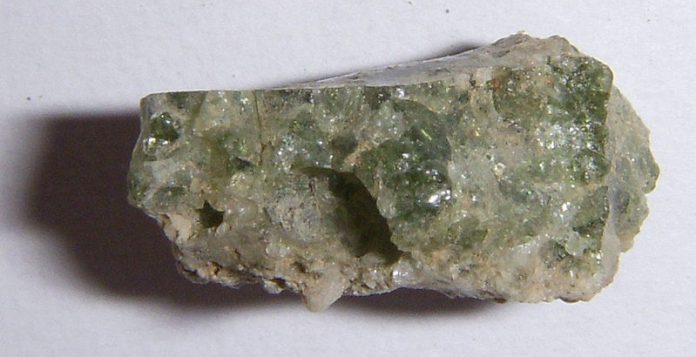
By Jim Brace-Thompson
A newly discovered crystal has been dated at 76 years old. I’d wager it’s pretty unusual for a geologist to say with supreme confidence how old a crystal is to the day, minute, and second. But then, this is no usual crystal. It’s a quasicrystal! And it was born at 05:29:21 am MWT (Mountain War Time) on July 16, 1945. The mother of that crystal? America’s first test of an atomic bomb in a top-secret detonation code-named “Trinity.”
Earth scientists and aficionados of exotic minerals have long known of trinitite. (I have a tiny, tiny piece in my own collection.) That radioactive green glass was spread around the vicinity of the atomic explosion in New Mexico when it was created by silica-rich desert sands that melted and fused under 18.6 kilotons of power and temperatures equivalent to the surface of the sun.
Now, it turns out; there’s a new mineral in town to accompany trinitite. While most trinitite is green, geophysicist Terry Wallace (Los Alamos National Laboratory) took an interest in a rare red variety. The red comes from all that remains of copper transmission lines strung around the steel-framed test tower, which swung a little atomic bomb nicknamed Gadget.
Wallace teamed up with Luca Bindi (University of Florence) and four other scientists to poke around in red trinitite. They were poking for what are called quasicrystals. Most crystals have a predictably uniform and periodic structure. A quasicrystal (or quasiperiodic crystal) shows a structure that is ordered but not periodic and thus lacks so-called translational symmetry.
Quasicrystals have been found in rocks with a peculiar combination: some sort of metal content and exposure to a violent shock of extreme pressure and temperature. Thus, for example, they have been found within meteorites.
The combination of violent shock and a little bit of metal is what led Bindi’s team to poke into red trinitite. And sure enough. A poke here, a poke there, and out popped “a heretofore unknown icosahedral quasicrystal” some 10 micrometers wide. (For us nonscientists, that’s 0.00039 of an inch.) Composed of silicon, copper, calcium, and iron, it is a perfect match for Gadget’s test tower with its transmission lines (copper) and steel frame (iron) sunk into concrete (calcium) amid desert sands (silicon). In the words of one somber scientist, “cool!”















